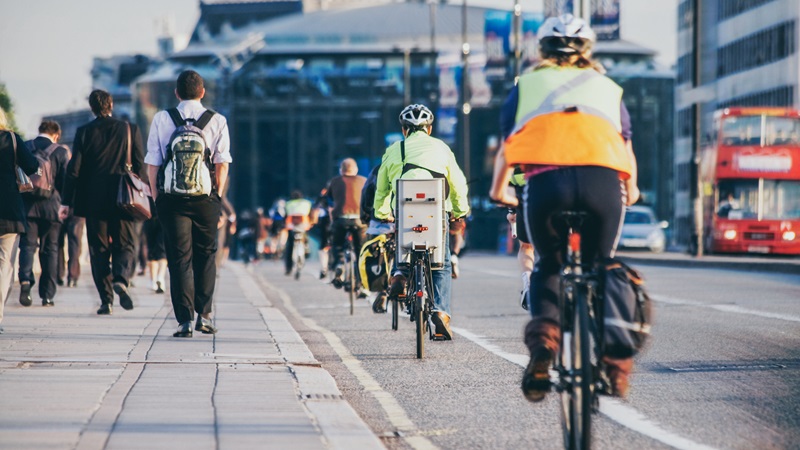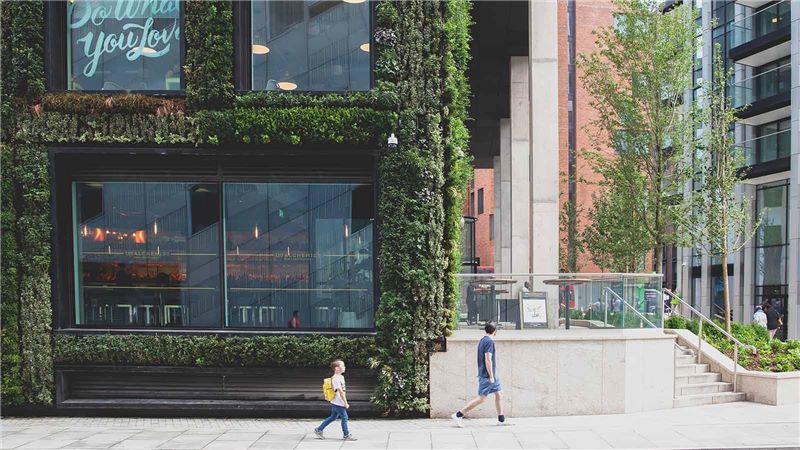Reimagining roadspace for a healthier future
When Transport Secretary, Grant Shapps, announced a £2billion package to support active travel as the country emerges from the coronavirus crisis, he declared that Britain had a ‘once in a generation’ opportunity to change the way people travel.
Bolstered by an initial £250million of funding to support the quick implementation of interventions to make cycling and walking safer, this bold claim is entirely plausible.
The added impetus now is the social distancing requirements imposed as a result of the devastating coronavirus. A need to not overcrowd the country’s public transport networks underpinned Shapps’ message.
Even though we’ve got to this position via an unfortunate route, it’s true that we have a better opportunity than ever before to make a change.
To build a clearer picture on this important topic, I hosted a virtual roundtable soon after the government announcement, inviting experts to share their views. Below, I have outlined the main takeaways from the session, which, when considered together, form a suite of ideas for how local authorities can make the most of the situation.
A two-pronged approach
While there will rightly be a significant focus placed on the importance of bringing infrastructure up to standard – to not only facilitate socially distanced travel, but to ensure people feel safe whether walking or cycling – people need to change the way they think about walking and cycling.
The government data points to a perfect storm that stops people from taking that first step. 61% of people think that cycling on the road is too dangerous, yet over 40% of urban journeys are under two miles and are perfectly suited to walking or cycling.
The quieter roads and cleaner air, combined with limitations on travel, have provided the impetus for people to make that change, at least temporarily – some places in the UK have seen a 70% rise in the number of people on bikes during lockdown.
We must retain these converts by making sure that they still feel safe on the road and convincing them that the benefits of walking and cycling outweigh those of other modes of transport.
Without a mass shift to walking and cycling, there’s a risk the new infrastructure could be underutilised; there needs to be an associated behaviour change. Dr Audrey de Nazelle from Imperial College, London, noted that now is a good time for this shift. With everyone more receptive and understanding of the benefits of walking and cycling – because of the current focus on public health – we don’t need as much campaigning effort as in the past.
Given this, Carlos da Rocha from Project Centre suggested that we could soften the typical British planning approach that places emphasis on public consultation and instead, during unique times requiring fast turnarounds, implement changes quickly with reduced consultation. Although I wouldn’t advocate a wholesale shift away from robust public consultation, there is unquestionably a need for local authorities to cut through some of the red tape if we are to put this infrastructure in place.
‘Quick and dirty’ has its benefits
Perhaps one of the biggest areas of contention on this topic is around the type of infrastructure interventions we should be implementing.
One school of thought is that, if we are to capitalise on the lockdown-inspired behavioural shift, we cannot afford to wait for permanent changes, but need to act quickly, using cones and plastic barriers to show progress. Robert Huxford from the Urban Design Group highlighted that the amount of funding currently available is not enough to deliver ‘gold plated’ solutions at the scale needed for a wholesale behaviour change. Right now, he says, local authorities need to look to the cheaper end of the spectrum to start making changes that will show people this is being taken seriously.
The other school of thought asserts that we should be taking the time to invest in interventions that will last and make people feel safe for years to come. Paul Foster from Leeds City Council highlighted how he and his colleagues are taking this opportunity to bring forward planned permanent interventions. This is taking place alongside low cost trials which fit with the city’s 800km cycling network ambition. The government funding has provided a chance to make changes as part of a ‘trial’ that, hopefully, will be made permanent over time.
Funding and time constraints will dictate that many local authorities have to opt for quicker and cheaper solutions. However, where plans are already in motion as part of an existing sustainable travel strategy, I would hope to see authorities taking their chances.
Integration and digitisation are key
If we are to see walking and cycling taken up by the masses, we need to be holistic in our thinking and recognise that people travel in different ways. One way of addressing this is through the creation of truly integrated transport networks, which need to be supported by digital innovation.
Dan Epstein, from Old Oak and Park Royal Development Corporation, spoke to this point, arguing for more coordination at a national level. This is a challenge that would require all levels of local and national government to work closely together so local, regional and national cycle networks connect with each other and allow for interchange with other modes of transport. Old Oak and Park Royal, with HS2 and Crossrail stations in development, could offer a model for how to achieve better transport integration.
We can look beyond the UK for inspiration too. Dr Lucy Mahoney from C40 Cities pointed to Paris as an example of how cycling infrastructure is being done well. In May 2020, the city began implementing its RER V project, a 650km network of permanent infrastructure, reaching out to the suburbs. This type of project, combined with improved subsidies to support the uptake of electric bikes – to assist those with more challenging journeys – could really transform the entire Paris region.
The smart phone is the ideal tool for enabling digital integration; bringing together route mapping, cycle hire schemes, and smart ticketing is a good start. Ian Clarke from National Clarion Cycling Club advocated this approach, arguing that there should be no reason why a train ticket can’t have cycle hire bolted on. It’s undeniable that digitisation will be crucial to unlocking integrated networks and organisations must come together to ensure compatibility.
Keeping an eye on the long-term prize
While these changes are being driven by the current pandemic, it is vital that we look to the future and ensure that interventions have longer lasting benefits.
The most obvious one is public health. Kerrie Smith, Senior Health and Wellbeing Manager at Mace, noted that before coronavirus the NHS was under strain from patients suffering from lifestyle related issues, such as obesity and heart disease. Getting people on their bikes, walking and jogging is an excellent way of helping to address this. There is the mental health aspect as well; as working from home becomes common practice, employers must encourage people to get out the house.
We also need to think about the socioeconomic benefits that can emerge from a shift towards walking and cycling and spread this message so businesses get on board – the potential increase in footfall at a café, for instance, shouldn’t be ignored, especially in the face of a recession.
There’s an important social angle too. Local authorities must implement their plans in a fair way, giving due consideration to poorer communities, which often rely more heavily on public transport to get around and may need more support to grasp the opportunity.
Ultimately, to ensure the long-term benefits are realised, we must avoid working in siloes. There is significant scope to the challenges and opportunities; social distancing, air pollution, physical and mental health, decarbonisation, social inequality, and economic growth to name just a few. We need to align our approach, both at the local and national level. By forming collaborative alliances and taking a holistic approach, we can strike while the iron is hot and avoid missing out on this ‘once in a generation’ opportunity.












